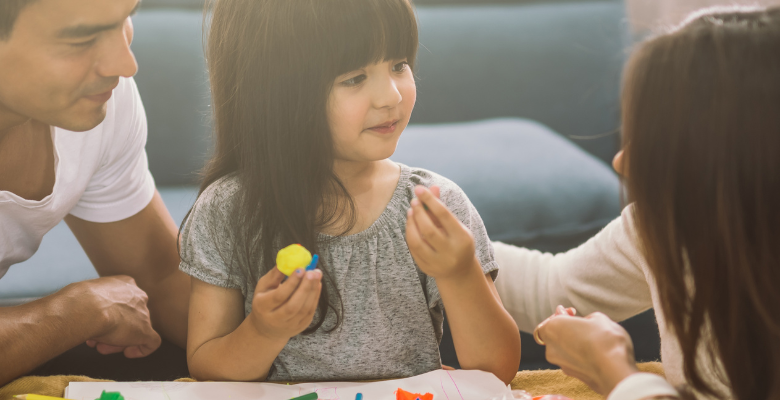Auditory perception is one of the key components of language development and communication. It’s an essential component to understanding speech and interpreting various sounds. Music-based activities have been shown to be effective in stimulating this type of learning among children. In this blog post, we will discuss some ideas for music-based activities that can aid in auditory perception training.
It is important to note that DISCRIMINATION IS THE KEY!
Auditory Perception Training is about working with kiddos/adults to discriminate the sounds in their environment. In other words, asking, “is this sound the same/different as another?”
Let’s dive right into activities that you can incorporate into your life with kiddos….
Hot and Cold Drumming
This game is a mixture between Hot and Cold and Hide-and-Seek.
One-On-One: Take an item and have one person hide it (make sure to give hiding guidance based on your kiddos age and stage). The person who hid the item is then the “drummer,” and they drum loud when the seeker gets close to the hidden object and gets quieter/softer when they are moving further away.
Group: Have one person selected to be the “seeker” and one to be the “hider.” The seeker has to close his/her eyes while the “hider” hides the object. The rest of the group waits and everyone has a drum. Once the object has been hidden and the “hider” returns to his/her original spot, the leader/adult tells the “seeker” to look up and start searching. The group works together to get loud when the seeker is getting close and softer when the seeker moves away from the object.
So much fun!
Highs and Lows
Have your kiddo have two instruments – one that is high (bells) and one that is low (drum) – and sing, play piano (it doesn’t have to a Beethoven Sonata – it can be a simple plucking on the piano that sounds good to you), have two instruments of your own that are high and low. Then play or sing and switch between the high and low. For piano this is simply playing on the right side of the piano for high and the far left side of the piano for low. For singing, pick a song that you can play around with high and low. (Ex: Ain’t No Valley High Enough – this song has high and low parts you can mess around with). Then have your kiddo switch between bells (high) and drum (low) at the corresponding time.
Echo and Sound Pattern Activities
Echoes and sound patterns are simple yet effective activities for developing auditory perception. With younger children, you can have them repeat back simple animal sounds such as the sound of a cow “moo” or a bird “tweet.” For more advanced activities, you can clap a sound pattern and then have the children repeat it back, which will test their memory and listening skills.
Another great activity is to have the kiddo make up a pattern or melody on the bells/piano, and then you repeat is back (sometimes correct and sometimes incorrect) and have the kiddo “grade” you on if you got it right or not. I do this often in therapy and sometimes my clients really get into it. I just thought as I’m writing this, that it would be fun to have a little buzzer or something to incorporate and make it more “game show” style.
Sound-Cued Movement
Find a way to make sound cue a movement. So many ways to do this!! Here are a few ideas:
- Play something fast for running and slow for a walk
- Run your hand across a piano/keyboard from left to right to cue standing up
- Run your hand across a piano/keyboard from right to left to cue sitting down
- Play an instrument quietly to tiptoe
And whatever other amazing ideas you come up with!
Symbol-Cued Sound
Okay, this is where art and music can run wide together have a blast! Come up with symbols (rainbow, heart, circle, unicorn, truck, shoe, etc..), and pair each symbol with an instrument or note or whatever musical objects you have. This can absolutely include pots and pans, tables, tapping shoes together, trash cans, anything that makes noise and won’t break.
Now, create a composition with your kiddo! It is even better when you decide on a song and create a rhythmic/melodic composition to go with it!
Rhyming
For younger kiddos this is learning words that are similar but not the same – hat/cat/fat – and learning to discriminate between these sounds. So appropriate games would be simple rhyming songs and finger plays, and nursery rhymes. Sing them with your child and do actions with the music. So incredibly beneficial to kiddos for auditory perception!
For older kiddos, where nursery rhymes may not be appropriate, find a song that has rhymes in it and have them learn actions to the different rhyming words.
Glass Jar
Take glass jars or wine glasses, fill each with a different amount of water, and have your kiddo determine the highest and lowest.
Environmental Sounds
Spend a few days focused on getting quick recordings of sounds in your environment (dog barking, garage door shutting, school bus, kid practicing an instrument, cooking, etc.) and then challenge kiddo(s) to identify the sounds. Make it a game. Everyone the get right, they can take a piece of broccoli of their plate for the night. Or they earn a star/sticker working toward something. Or they get a penny. Whatever is appropriate in your situation.
Match The Sound
Get an even number of jars or containers that you cannot see what is inside. Place one item inside two of the jars/containers (beans). Then in the next two jars/containers place another item (rice). Then in another two jars/containers another item (goldfish). Get it? Keep going for as many as you want. Then have your kiddo work on shaking and hearing each one and placing the matching sounds together.
Rhythm Recognition Games
Rhythm games help children learn the basic components of music and develop their listening skills. These games help them distinguish between various music notes and beats. An effective rhythm game is to use clapping hand game using different patterns and rhythms, starting with a simple beat and building up to more complex ones.
Singing
Singing helps children learn about melody and sound variation. You can use nursery rhymes or any popular song to get children singing along, focusing on the different intonations and tones. This skill is especially important for children who need to improve their pitch recognition.
Since discrimination is the key, after listening to several songs in the car, ask your kiddo which songs sound happy/sad/etc. Have them discriminate the difference in music. What made this song different than the last one? (Maybe it is – this song has more strings/violins and the other was mainly drums)
On the same token as listening and singing songs and identifying their emotional/lyrical meaning, you can make it a game at home with emotion cards or stuffed animals (I included some emotion stuffed animals below), and while listening to a song, have your kiddo pick which emotion it is. This is important for identifying emotions in conversation and social interactions.
Musical Instrument Play
Playing musical instruments gives children the opportunity to learn about the different sounds that they can produce. They can hear how these various instruments sound and learn how to differentiate between them. Introducing different instruments such as drums, tambourine, and maracas can help give an added depth of perception training, and can be particularly helpful in sensory integration training.
Listening and Identifying Sounds
This activity entails playing a range of sounds for children. For example, you could play sounds of animals, cars, trains, and other everyday sounds, and then have the children identify them. This activity will help children develop their listening skills while also helping them identify a range of sounds.
Well, all-in-all, I hope there are at least a few activities that inspire your caregiver-self to help the kiddos in your world by helping strengthen and refine their auditory perception. Music-based activities are a fun and effective way to train auditory perception skills among children. These activities help children differentiate sounds, recognize pitch, and develop their listening skills. Whether you’re a teacher, parent, or guardian, incorporating music-based activities into children’s everyday routine is a great way to support their auditory perception development. Remember that music-based activities should also be implemented in conjunction with other auditory perception training to provide children with a wholesome learning experience.



